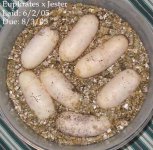Jessica71
New member
Just wondered if anyone else's corn eggs have lots of these star markings on. These are from a two year old anery corn - it's her first batch, and they were laid on May 29th (ten altogether). The markings were present at laying but have become more noticeable. Do you think they look ok? The temperature is around 82-84, humidity just over 80%; they're on dampish vermiculite. I'm sure it's not mold and they feel reasonably turgid. They became less turgid a week ago but I've made the vermiculite damper (I've experimented - when the humidity gets much higher the condensation drips off the box lid, even though there are ventilation holes). And they don't smell off. I tried to candle them and thought I saw something, but was nervous about shining light on them for too long so gave it up.
Any advice appreciated - I'm a first time breeder as well as the snake!
Thanks,
Jessica
Any advice appreciated - I'm a first time breeder as well as the snake!
Thanks,
Jessica






